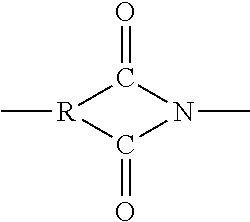Composite Perfluorohydrocarbon Membranes, Their Preparation and Use
a perfluorohydrocarbon membrane and perfluorohydrocarbon technology, applied in the field of composite perfluorohydrocarbon membranes, can solve the problems of poor separation, adversely affecting separation efficiency, solvent wet out, etc., and achieves the effects of improving solvent resistance, cost-effective and industrially feasible, and improving uniform pore structur
- Summary
- Abstract
- Description
- Claims
- Application Information
AI Technical Summary
Benefits of technology
Problems solved by technology
Method used
Image
Examples
example 1
Preparative Example 1
[0109]This preparative example describes preparation of porous PEEK substrate modified with hydroxyl groups in a single step pore formation surface modification process.
[0110]A precursor 25μ thick film was obtained by compression molding PEEK / PEI blend (50:50 by weight pre-blended in a twin extruder) at ca. 370° C. followed by quenching in water. The film was then heat treated at 250° C. for 1 hour to affect crystallization of PEEK polymer. The film was then placed into neat monoethanolamine solution maintained at 120° C. for 4 hours. The solution was blanketed with nitrogen. The thus formed porous PEEK film was washed with IPA and then Soxlet extracted with methanol overnight. The porous film was then dried under vacuum at 80° C. overnight. The elemental analyses indicated that the film contained 1.26% of nitrogen. No residual polyimide was detected by FT-IR analyses. The nitrogen presence was attributed to formation of imine groups.
example 2
Preparative Example 2
[0111]This preparative example describes preparation of porous PEEK substrate without surface modification.
[0112]A precursor film was obtained by compression molding PEEK / PEI bled (50:50 by weight pre-blended in a twin extruder) at ca. 370° C. followed by quenching in water. The film was then heat treated at 250° C. for 1 hour to affect crystallization of PEEK polymer. The film was then placed into solution comprised of DMF, monoethanolamine and water 90 / 5 / 5 by volume at 100° C. for 4 hours. The solution was blanketed with nitrogen. The thus formed porous PEEK film was washed with IPA and then Soxlet extracted with methanol overnight. The porous film was then dried under vacuum at 80° C. overnight. The elemental analyses indicated that the film contained 0.09% of nitrogen. No residual polyimide was detected by FT-IR analyses. The results indicate that thus obtained porous PEEK substrate is essentially free of surface modification via imine group formation.
example 3
Preparative Example 3
[0113]This preparative example demonstrates preparation of PEEK substrate functionalized with hydroxyl groups by selective reduction of surface ketone groups.
[0114]A porous PEEK film prepared as described in Preparative Example 2 was pre-dried under vacuum at 100° C. overnight. The pre-dried film was then placed into a 0.1% sodium borohydride solution in isopropyl alcohol and refluxed for 8 hours. The film was then washed sequentially with dilute HCl solution (0.1N) and distilled water and then dried under vacuum at 80° C. to a constant weight. The thus obtained film was found to be highly hydrophilic and spontaneously wetted with water.
PUM
| Property | Measurement | Unit |
|---|---|---|
| pore size | aaaaa | aaaaa |
| pore size | aaaaa | aaaaa |
| temperature | aaaaa | aaaaa |
Abstract
Description
Claims
Application Information
 Login to View More
Login to View More - R&D
- Intellectual Property
- Life Sciences
- Materials
- Tech Scout
- Unparalleled Data Quality
- Higher Quality Content
- 60% Fewer Hallucinations
Browse by: Latest US Patents, China's latest patents, Technical Efficacy Thesaurus, Application Domain, Technology Topic, Popular Technical Reports.
© 2025 PatSnap. All rights reserved.Legal|Privacy policy|Modern Slavery Act Transparency Statement|Sitemap|About US| Contact US: help@patsnap.com



